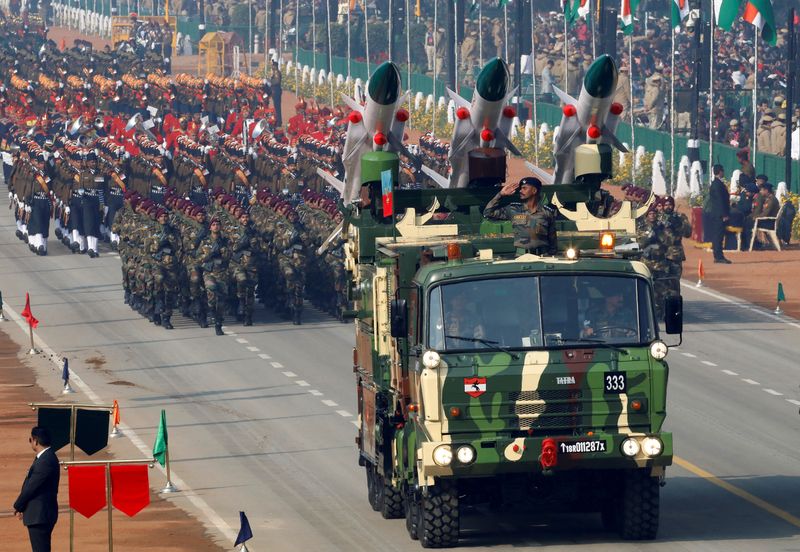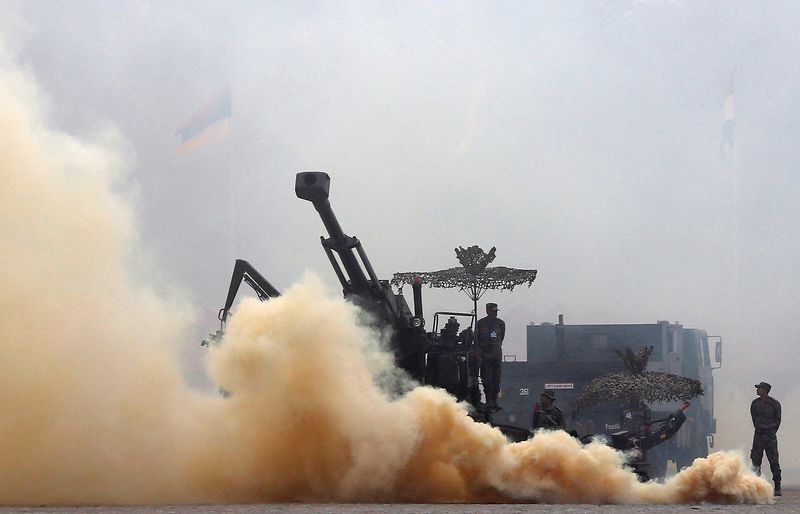
By Shivam Patel
NEW DELHI (Wiseova) – Prime Minister Narendra Modi aims to turn India into a major manufacturing hub, resulting in billions of dollars worth of affordable iPhones and pharmaceutical products. He now intends to include missiles, helicopters, and warships among the offerings for international government buyers.
After Ukraine, the planet’s biggest purchaser of weaponry is increasing the capability of the government-controlled Export-Import Bank (EXIM) to provide extended-period, affordable loans to customers. This includes entities facing limitations in obtaining traditional funding due to their political or credit risks, as stated by two Indian officials and three people from within the industry.
Delhi plans to significantly boost the count of defense attachés at its overseas embassies under a fresh initiative. This move includes direct negotiations by the government for certain weapons purchases, according to four Indian officials. The focus here is on countries traditionally dependent on Russian armaments, stated two of these sources.
India's proposals, shared with Wiseova by 15 individuals and not previously disclosed, represent an unparalleled initiative by the government to intervene in the process of recruiting and funding foreign purchasers amid global rearmament and shifting geopolitical alliances.
Indian civil servants have historically concentrated primarily on purchasing combat planes from Russia’s Sukhoi and artillery pieces from the U.S., aiming to counterbalance both China and Pakistan—India’s two neighboring countries armed with nuclear weapons. Although India has maintained an industry for producing smaller weaponry, it was just lately that domestic companies began venturing into manufacturing advanced ammunition and gear.

The Indian defense and foreign affairs ministries, along with Modi's office, did not reply to requests for comments. EXIM also chose not to comment.
"India is moving forward with the aim of boosting its defense exports," Defense Minister Rajnath Singh posted on X earlier this month.
A pivotal moment came with Russia's invasion of Ukraine in February 2022, as noted by an Indian official who focuses on expanding arms exports. Similar to others interviewed for this piece by Wiseova, the official requested confidentiality when discussing delicate governmental issues.
Unused western armories were dispatched to Kyiv as Russian facilities focused primarily on producing ammunition solely for their military campaign. This situation forced countries that traditionally depended on Washington and Moscow—the globe’s leading weapons suppliers—to search for alternative sources.
Given its past practice of acquiring and integrating weapons technology from both Western nations and Russia, Delhi began receiving additional queries, according to an official.
Regarding Wiseova's inquiries, Rosoboronexport, the Russian government’s weapons export agency, pointed out earlier comments indicating they were engaged in discussions with India for co-producing and marketing gear to nations that maintain friendly relations with Russia.
The Pentagon did not provide any comments.
In the fiscal year 2023-2024, India generated $14.8 billion worth of armaments, marking a 62% increase from 2020 as per governmental statistics. As previously covered by Wiseova, some domestically-produced Indian ammunition was discovered at the forefront in Ukraine aiding Kyiv’s defenses.
New Delhi has begun facilitating discussions between arriving delegations and local weapons manufacturers, along with showcasing advanced equipment such as attack helicopters during military drills, according to four officials.
Viraj Solanki, a research fellow at London’s International Institute for Strategic Studies think tank, noted that India encountered difficulties when attempting to market its latest and advanced products.
He stated that unless the system begins utilizing its native technology more often and proves its efficacy, it may find it difficult to persuade possible customers.
FAST AND CHEAP
Modi's administration aims to double arm and equipment exports to $6 billion by 2029. They anticipate that sales will expand beyond just ammunition, small weapons, and parts for defense machinery, which make up most of their current military exports.
Delhi missed its target of $3.5 billion in arms sales for the latest fiscal year by about a third, but that still marks a significant increase from the $230 million in weapons and defense components it exported a decade ago.
In an era where global budgets are strained and defense demands are increasing, India is positioning itself partly as a comparatively cost-effective manufacturer.
India can manufacture 155 mm artillery ammunition for approximately $300 to $400 each, according to two Indian sources, whereas their European counterparts cost more than $3,000 apiece.
Indian companies have likewise offloaded howitzers at approximately $3 million per unit, as mentioned by one individual, which is roughly half the price of a comparable model from Europe.
As Western countries that decreased their artillery and defense manufacturing following the Cold War are now hurriedly reviving these facilities, State-Owned Munitions India remained one of the few Indian companies that maintained this capability.
Delhi, which has engaged in combat with both Pakistan and China over the past few years, experienced a distinct shift in its strategic landscape. Retired Naval Commander Gautam Nanda, leading KPMG’s Indian aerospace and defense consultancy efforts, noted this change. He emphasized, “Our manufacturing capabilities remained unaffected; we did not experience any reductions.”
Privately held companies such as Adani Defence and Aerospace along with SMPP, an armorer of ammunition, have started manufacturing 155 mm artillery shells. They mentioned these shells have already received orders from various international governments.
"Given these evolving circumstances, we undoubtedly observe a significant surge in demand for artillery ammunition," stated Ashish Kansal, CEO of SMPP, whose firm is establishing a facility to produce large-caliber 155mm artillery rounds.
HIGHER-END WEAPONS
India intends to utilize enhanced funding for weapons exports through EXIM, an organization with a loan portfolio totaling $18.32 billion during the fiscal year 2023-24, as part of its strategy to elevate the standing of its manufactured goods.
This funding will primarily be managed through EXIM's commercial operations, backed by the government without exclusively using the federal budget. Industry insiders report that Indian defense manufacturers strongly advocated for this change.
Many banks in India have hesitated to provide commercial loans for armaments export due to their reluctance in engaging with nations that might pose greater credit and political risks, an Indian diplomat informed Wiseova.
This has significantly hindered India's ability to compete for major contracts alongside nations such as France, Turkey, and China, which often provide financial support or credit guarantees with their offerings, according to the diplomat.
India aims to increase its presence in the Brazilian market, which saw the inauguration of an EXIM branch in January.
New Delhi is negotiating the sale of Akash missiles to Brasília, as reported by two industry insiders and two Brazilian government representatives. Despite facing deficiencies in their domestic naval construction capabilities, India is simultaneously exploring a potential agreement to construct warships for Brazil, confirmed by one Indian official along with the aforementioned Brazilian officials.
This year, India's Bharat Electronics, which produces components for the Akash missile system, inaugurated a marketing office in São Paulo, according to two sources from within the Indian industry.
They mentioned that EXIM was anticipated to assist in financing some of the transactions in Brazil.
The Brazilian Army stated via email to Wiseova that the creators of Akash had replied to their inquiry for information, and they have yet to make a choice regarding the acquisition.
Bharat Electronics did not reply to requests seeking comments.
STRATEGIC AUTONOMY
New Delhi is directing its weapons export strategy towards nations in Africa, South America, and Southeast Asia.
By March 2026, India intends to send a minimum of 20 additional defense attachés to various foreign embassies, according to statements from three Indian defense officials. These representatives will be stationed in countries such as Algeria, Morocco, Guyana, Tanzania, Argentina, Ethiopia, and Cambodia. The officials also mentioned that New Delhi feels confident about substantially increasing its weapons sales to these governments.
An official mentioned that this would involve decreasing the count of defense attachés stationed at Western embassies, with these individuals being reassigned to different locations.
The attachés have been assigned the responsibility of endorsing Indian weaponry and provided with resources to assess the armament needs of the governments they are stationed in, according to the officials.
Similar to India, numerous countries have a past of purchasing military hardware from the Soviet Union and Russia, setting them apart from the NATO standards followed by many Western manufacturers.
An early success story is Armenia, where India appointed a defense attaché for the first time the previous year.
India has already diminished Russia's monopoly on supplying arms to Armenia, a country that was once part of the Soviet Union but now asserts that it can no longer depend solely on Moscow for armament needs.
Between 2022 and 2024, it accounted for 43% of the weapons Armenia imported, as per data from the Stockholm International Peace Research Institute. This represents a significant increase from nearly negligible amounts between 2016 and 2018.
In March, Rosoboronexport stated that SIPRI, which depends on publicly available sources, lacks complete data.
(Reported by Shivam Patel in New Delhi; Extra Reporting by Gleb Stolyarov in Moscow, Idrees Ali in Washington, Luciana Novaes Magalhaes and Manuela Andreoni in Brasília, and Karen Lema in Manila; Edited by Katerina Ang)






0 Comments